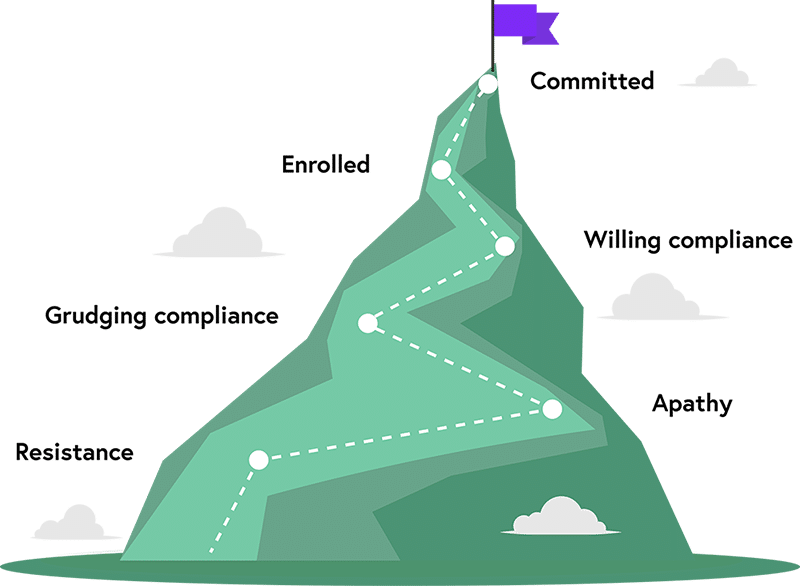The key to successful workplace change
Successful workplace change is hugely dependent on your team being adaptable, having clarity of the new goals or new structure, wanting to work together to make it happen, and having good relationships with each so they can support each other when it’s tough and collaborate/innovate well as required.
As a team leader, you will need people working with you, not against you. You will need people who want to work, not people who begrudge the time they spend at work. You will need a team who enjoy learning continuously, not resisting all development and new thinking.
So let’s find out exactly how to create this type of team…

The six levels of engagement
If you were to do a quick assessment of your team members against this six levels of engagement model, would you find your current team is mostly at the top, spread across the levels, or would you have a dominance at the bottom?
Think about where you would place yourself and your team members, or if you would like to complete this as an exercise you can download a free interactive worksheet using the form below. Write the initials of your team members in relation to where they are.

A team towards the bottom
If your team is clustered towards the bottom, you can probably rule out any easy or successful workplace change programme. Your people simply will not be working with you and if you don’t all pull together, in our experience, the ship tends to sink. If you have none who are towards the top, you also don’t have enough pulling with you for you to be able to set a good example for the rest, to create better engagement. You need more than just one engaged manager for a team to succeed. If this is the case, you may find it is easier to disband or dismiss the one or two who drag others down, than seek to develop.
As an alternative, forget change for five minutes and instead run a couple of structured team building sessions focussed on identifying those who are interested in turning it (i.e. their level of engagement) around, those who need a nudge or two and/or just a bit of support to turn it around and those who are what we might call ‘toxic’, with no interest in every really working with you and pulling in the same direction. Then…
- Remove anyone who is toxic from the team. This must be done legally so make sure you ask for advice on managing someone out (on grounds of misconduct, not performance) who has a bad attitude with all the low quality, low performance that arises from that.
- Communicate with, and develop, those who have been struggling.
- Reward and praise those who strive to deliver what you are asking of them.
A team towards the top
If your team is mostly towards the top, then that’s brilliant but make sure you continue to communicate, thank and engage with them at every stage of your change programme. These people give you your best chance of success at achieving sustainable change so make sure to remember how lucky you are!
Ideas for thanks and engagement aside from more structured approaches such as pay, bonuses and promotions, might include:
- Actually saying ‘thank you’.
- Small, meaningful gestures that reflect the person’s interests such as a dinner at a restaurant, a voucher related to interests, half a day off.
- A letter, little award or certificate that puts in writing what they are great or successful at.
- An early finish one day for the team that has worked hard together.
Note: Make sure your thanks is meaningful, personal, never predictable or often repeated and lazy. A lazy box of cupcakes every Friday is just not going to cut it!
A team spread across six levels
If your team is spread across the six levels, then you have some decisions to make and will need to invest some time into your people if your change programme is to succeed.
A few considerations and questions:
- People towards the bottom can drag everyone down to their level if you’re not careful. Bad mood and bad attitudes spread like wildfires. You therefore need to stop it spreading – fast.
- Those at the top will not be tolerant of any under performers that drag the whole team down, so make sure to let them know how you’re managing those who are under performing or disengaged. If you want to retain great people, being discreet and slow to make tough decisions is not going to be helpful.
- Observe everyone’s actions rather than listen to the words they use, as it’s actions that are key to making a proper assessment of where someone is at on our mountain/wonky pyramid. Also check any biases you have to ensure you’ve pegged everyone at the right level. Horns bias will tend to make you only see the negatives, halo bias will potentially blind you to someone’s true behaviours or potential. Remember too, to carefully consider those who are less visible, for example any remote workers or introverts, talk to them before making an assessment and be careful not to make ill informed judgements. Check and challenge your own thinking, continuously!
- Those in the middle may be questioning whether the team is going to hold together and what their role in that is. What’s needed to step them up a level rather than have them sink a level? Consider whether they have always been at this level or whether there is evidence they have operated at a different level. If so, what caused the change?
- As leader what might YOU be doing differently to invest in your team, to inspire your team, to develop your team? Have you been a bit complacent, so now you need to take action? Have you had your eye off the ball, but now cracks in the team are showing? Do you lack the skill set or confidence to turn this around. Do you need to get some HR support? What do YOU need to work on first, before you can begin to work on your team?
Hopefully using just this simple model of six levels of engagement we have given you some food for thought if you are managing through a period of change.
How Jaluch can help…
This material is taken from the module on Managing Conflict in the Jaluch Leadership Development Programme – 24 topics across year 1, building knowledge, competence and confidence continuously. Ask us for details or check out the leadership programme brochure.
We can also deliver live-online or face-to-face training sessions on managing conflict or managing change.
📩 If you liked this article and want more, sign-up to receive free fortnightly updates from us.
Disclaimer: The information contained within this article is for general guidance only and represents our understanding of employment and associated law and employee relations issues as at the date of publication. Jaluch Limited, or any of its directors or employees, cannot be held responsible for any action or inaction taken in reliance upon the contents. Specific advice should be sought on all individual matters.
